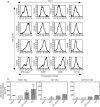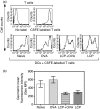A novel synthetic adjuvant enhances dendritic cell function
- PMID: 19740319
- PMCID: PMC2753928
- DOI: 10.1111/j.1365-2567.2008.03038.x
A novel synthetic adjuvant enhances dendritic cell function
Abstract
The lipid core peptide (LCP) is a novel, synthetic, self-adjuvanted vaccine delivery system that neatly incorporates the adjuvant, carrier and antigenic peptides of a vaccine into a single molecular entity. This system has been previously shown to efficiently deliver vaccines and induce immunity. Because adjuvants target sentinels of the immune response, such as dendritic cells (DCs), that are widely distributed throughout the body to initiate specific immune responses, we investigated the effects of the adjuvant on DCs. Here we show that LCP targets vaccines to DCs and induces their activation.
Figures





Similar articles
-
AS04, an aluminum salt- and TLR4 agonist-based adjuvant system, induces a transient localized innate immune response leading to enhanced adaptive immunity.J Immunol. 2009 Nov 15;183(10):6186-97. doi: 10.4049/jimmunol.0901474. Epub 2009 Oct 28. J Immunol. 2009. PMID: 19864596
-
Immunoregulatory properties of a crude extraction fraction rich in polysaccharide from Chrysanthemum zawadskii Herbich var. latilobum and its potential role as a vaccine adjuvant.Int Immunopharmacol. 2021 Jun;95:107513. doi: 10.1016/j.intimp.2021.107513. Epub 2021 Mar 20. Int Immunopharmacol. 2021. PMID: 33756223
-
Protein-bound polysaccharide activates dendritic cells and enhances OVA-specific T cell response as vaccine adjuvant.Immunobiology. 2013 Dec;218(12):1468-76. doi: 10.1016/j.imbio.2013.05.001. Epub 2013 May 13. Immunobiology. 2013. PMID: 23735481 Free PMC article.
-
Adjuvants Enhancing Cross-Presentation by Dendritic Cells: The Key to More Effective Vaccines?Front Immunol. 2018 Dec 13;9:2874. doi: 10.3389/fimmu.2018.02874. eCollection 2018. Front Immunol. 2018. PMID: 30619259 Free PMC article. Review.
-
Modulating vaccine responses with dendritic cells and Toll-like receptors.Immunol Rev. 2004 Jun;199:227-50. doi: 10.1111/j.0105-2896.2004.00144.x. Immunol Rev. 2004. PMID: 15233738 Review.
Cited by
-
HBVsvp-Pulsed Dendritic Cell Immunotherapy Induces Th1 Polarization and Hepatitis B Virus-Specific Cytotoxic T Lymphocytes Production.Infect Drug Resist. 2020 Aug 5;13:2699-2709. doi: 10.2147/IDR.S265681. eCollection 2020. Infect Drug Resist. 2020. PMID: 32821133 Free PMC article.
-
Designer lipids for drug delivery: from heads to tails.J Control Release. 2014 Sep 28;190:274-87. doi: 10.1016/j.jconrel.2014.04.047. Epub 2014 May 6. J Control Release. 2014. PMID: 24816069 Free PMC article. Review.
-
Lipopeptides for Vaccine Development.Bioconjug Chem. 2021 Aug 18;32(8):1472-1490. doi: 10.1021/acs.bioconjchem.1c00258. Epub 2021 Jul 6. Bioconjug Chem. 2021. PMID: 34228433 Free PMC article. Review.
-
T4 Phage Displaying Dual Antigen Clusters Against H3N2 Influenza Virus Infection.Vaccines (Basel). 2025 Jan 13;13(1):70. doi: 10.3390/vaccines13010070. Vaccines (Basel). 2025. PMID: 39852849 Free PMC article.
-
Targeting TLR2 for vaccine development.J Immunol Res. 2014;2014:619410. doi: 10.1155/2014/619410. Epub 2014 Jun 26. J Immunol Res. 2014. PMID: 25057505 Free PMC article. Review.
References
-
- Moyle PM, Olive C, Ho MF, Good MF, Toth I. Synthesis of a highly pure lipid core peptide based self-adjuvanting triepitopic group A streptococcal vaccine, and subsequent immunological evaluation. J Med Chem. 2006;49:6364–79. - PubMed
-
- Olive C, Batzloff MR, Horvath A, Clair T, Yarwood P, Toth I, Good MF. Group A streptococcal vaccine delivery by immunization with a self-adjuvanting M protein-based lipid core peptide construct. Indian J Med Res. 2004;119(Suppl.):88–94. - PubMed
-
- Zhong G, Toth I, Reid R, Bruhman RC. Immunogenicity evaluation of a lipidic amino acid-based synthetic peptide vaccine for Chlamydia trachomatis. J Immunol. 1993;151:3728–36. - PubMed
-
- McLellan A, Kapp M, Eggert AA, Linden C, Bommhardt U, Brocker E-V, Kammerer U, Kampgen E. Anatomic location and T-cell stimulatory functions of mouse dendritic cell subsets defined by CD4 and CD8 expression. Blood. 2002;99:2084–92. - PubMed
Publication types
MeSH terms
Substances
LinkOut - more resources
Full Text Sources
Medical

